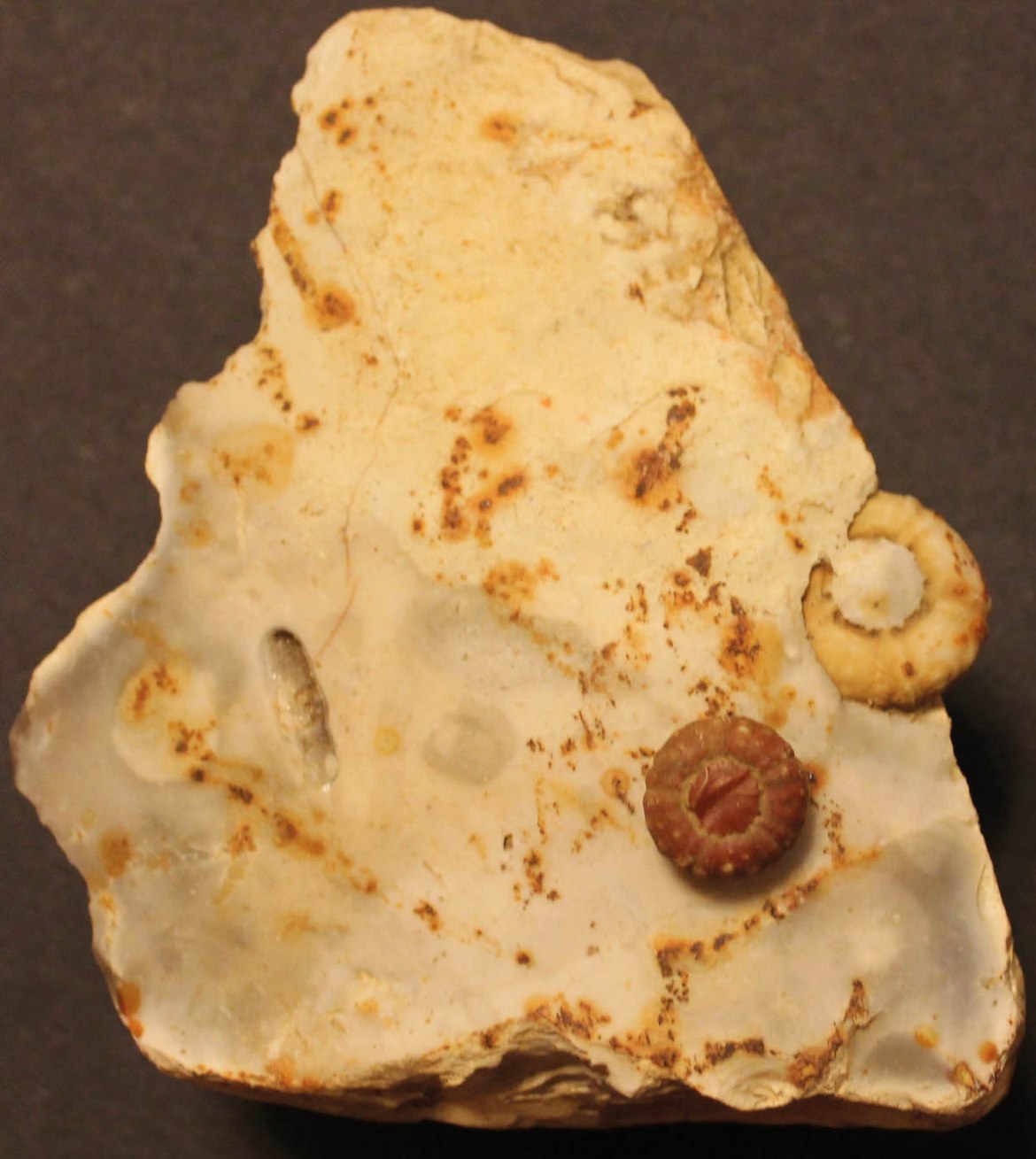Humble flint sea urchins and the stories they tell
Joe Shimmin (UK)
Flint is a very hard-wearing rock from the chalk of the Upper Cretaceous. Whole beaches made of flint pebbles can be found many miles away from the chalk strata that the nodules originated in, owing to the rock’s ability to withstand the processes that destroy other rocks quickly. Flint sea urchins are especially hard-wearing, as their rounded shapes require a lot of force to damage, while less-rounded flints tend to break up over time if subjected to high-energy environments, such as beaches and fast-flowing rivers. Because of this robustness, it is possible to find flint urchins, which have undergone some very interesting journeys before being collected, adding to their interest for fossil hunters.

All flints start off within chalk strata. Where these strata are exposed at the coast or in quarries and cuttings, it is possible to collect flint sea urchins, which, at first, look very much as if they are preserved like every other urchin found in chalk. They have a white calcite-replaced test and all that can be seen of the flint within is a slight blueish tint or maybe a glimpse of the nodule through the anal or oral apertures. Of course, flints can also be found that partially or fully envelop an urchin and, in these cases, highly aesthetic display pieces can sometimes occur.

Once worn out of the chalk, the external calcite test will quickly become damaged and abraded in beach environments, owing to its comparative softness. In these cases, to maximise the detail and aesthetics of the fossil once collected, I have sometimes stripped off the battered test using acid, to reveal a perfect flint internal mould, which is often covered in a fine tracery of silicified fragments of the test. Beach-found urchins with their white test still remaining, but damaged, may have been out of the chalk for any amount of time between a few hours and a few years, depending on how exposed they have been to the rolling action of the sea.
More time rolling around on a beach will strip off all calcite from a specimen, as well as any silicified traces; and a smoothed, rather undetailed, urchin will remain, with only a neat five-fold pattern to show where the spines were. So, in a highly erosive environment such as a beach, a fossil urchin specimen has a context and a story to tell, even if it is only short.

Most beach-found urchins, where the calcite test no longer remains, appear in fairly fresh blue/black flint as the weathering processes that change a flint’s surface colour, or patina, occur more slowly than the erosive processes that reduce urchins to featureless flint nodules. However, I have flint urchins in my collection that have quite a range of colours. These have developed in lower energy environments, during the fossils’ ‘journeys’ since eroding out of their chalk strata, where enough time has elapsed to allow a patina to form.

Chalk does not only erode at the surface. Beneath the soil, acid in the rainwater slowly breaks down the chalk, liberating flint nodules, including sea urchin fossils. Depending on the soil type that the urchin fossil then sits in, various coloured patinas develop, ranging from off-white in chalky, alkaline soils to dark brown in iron-rich soils.

The surface detail of a field-found urchin can give clues as to how much transport it has undergone since its liberation from the chalk. In the example shown in Fig. 8, the silicified tracery left behind after the calcite test dissolved can be seen, making it probable that the specimen has moved but a little from its origin, as this fragile detail is quickly lost during natural transportation. Conversely, smoothed field finds indicate transport, usually by water, from their original locations. If the wear to the fossil is even, it can be supposed that the fossil rolled consistently during its journey. If one side is more worn than another, it can equally be supposed that, for some period of time, one side of the fossil was buried, either in a river bed or a river bank, while the other was abraded.

The approximate date of transportation in rivers can also, sometimes, be ascertained. I have found flint sea urchins in river terrace gravels, where the dating convention runs that the higher the terrace, the older it is. Following a little research, I can make an informed guess that the examples shown in Fig. 10 were transported during Marine Isotope Stage 5e, approximately 120,000 years ago, as they were found in river gravels at sea level.



Having grown up in a flint-rich area, flint urchins were the first fossils that I ever came into contact with and they inspired me to become a fossil collector. Over the years, they have remained a firm favourite of mine due to their beauty and their ‘back stories’, which I enjoy trying to figure out. So, while they are not the rarest or most valuable specimens in my collection, fossil urchins preserved in flint do hold a strong and enduring appeal for me. Next time you find a fossil flint urchin, try playing detective yourself. Can you ‘read’ its story?


Further reading
Fossils of the Chalk: Guide, Palaeontological Association No 2 (2nd edition), edited by Andrew B Smith and David J Batten, The Palaeontological Association, London (2002), 374 pages (Paperback), ISBN: 0901702781
Logging the Chalk, by Rory N Mortimore, Whittles Publishing, Caithness, Scotland (2014). 357 pages, (hardback), ISBN: 978-184995-098-5
The Chalk of Sussex and Kent, Geologists’ Association Guide No 57, by Rory N Mortimore, The Geologists’ Association, London (1997), 139 pages (Paperback), ISBN: 0-780900717833

